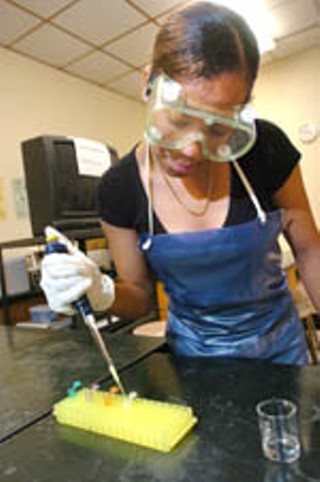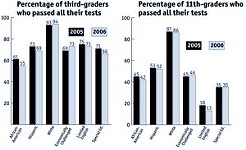A Science Experiment
AISD's Young Women's Leadership Academy aims to point more girls toward science
By Rachel Proctor May, Fri., March 10, 2006

Knee socks and test tubes, little plaid skirts and pocket protectors. Are Austin girls ready to go wild for science?
AISD thinks so. (Or at least, AISD has gone wild at the thought of the $1 million planning grant Dallas philanthropist Lee Posey has offered AISD to get the project off the ground.) In any case, plans for a Young Women's Leadership Academy are now officially under way, with the district betting its Bunsen burners that if you throw a single-sex environment and high expectations at a bevy of brainy beauties, they'll lift their aspirations and reveal their inner Edisons.
The YWLA, which will open in the fall of 2007 with 115 students each in seventh and eighth grades, will eventually grow to 800 students in grades 6-12. The program will emphasize science, which is of course gender-neutral, but the schools will girl-ify in other ways, such as tailoring PE to the gentler sex (yoga … salsarobics … mud wrestling …). We hear the ladies may also dissect unicorns and butterflies in lieu of frog bellies and cow eyes.
At the simplest level, the YWLA is a nod toward the continued underrepresentation of women in science – according to the National Science Foundation, women account for just 22% of working scientists and engineers in the United States. Plus, we have a bigger problem with science in general: NSF and the National Academies of Sciences both released bleak reports this year (NAS gave theirs the chipper title "Rising Above the Gathering Storm") warning that too few Americans are entering what our brainiac president might call the "nerd" fields. It seems the can-do nation has become the someone-else-can-do-it nation when it comes to science and high tech, and that bodes ill for the economy.
The YWLA may take the U.S. only one small step toward a brave new world of pink lab coats, but it will take AISD a significant step toward a "portfolio" of specialized academies that, it promises, will replace the comprehensive high schools we've all known and hated. Every AISD high school, for example, is currently undergoing a "redesign" process to create thematically organized "small learning communities," such as the high tech academy Akins has in the works. YWLA will go a step further; it may even be an "in-district charter" – independently operated and governed by its own school board, but residing under AISD's financial umbrella. Charter-izing would allow the YWLA great freedom to develop unique curricula and to independently fundraise for goodies like laptops. It has other aims as well – AISD Superintendent Pat Forgione is clear that he feels the way to compete with charter, private, and Catholic schools is to do what they do, only better. "I firmly believe the way I'm going to head off vouchers is I'm going to give you such good choices you'd never even consider it," he said.
A market approach to public schools is not without potential pitfalls. Not least of which is middle class parents' demonstrated preference for schools with few poor kids. Then again, with economic segregation already an on-the-ground reality for much of AISD, perhaps a more relevant question is whether the portfolio plan could improve upon the situation.
For consultant and former school board member Ingrid Taylor, the difference is scale. When AISD offers only a few choices – essentially the three "magnet" programs – it's obvious why they skim the very best students away from struggling schools. A larger variety of high-quality programs could, theoretically, better disperse strong students into specialized academies throughout the district. "If you really do create the portfolio, then it's something potentially more powerful," Taylor said. "We don't know what the potential is yet because we haven't gone there."
As for concerns that only parents already engaged with their children's education will take advantage of the new options, Ken Zornes of the Texas Business and Education Coalition argues large-scale public school choice would leave parents no other option. "If the choices are there, people would be forced into looking at the options they have," said Zornes. "That in itself would make them more involved."
In the short term, AISD says it's committed to ensuring the YWLA does not become a middle-class magnet. The district says the YWLA will serve mostly girls from low-income backgrounds, although for the sake of diversity it may set aside a quarter of the slots for girls of any income. However, AISD hasn't yet figured out a mechanism for finding these low-income girls – the current proposal of prioritizing students from "ZIP codes of poverty" could easily turn into another way middle-class gentrifiers escape schooling their children with their neighbors.
Over the long term, the choices are likely to increase. According to Forgione, other organizations have approached AISD with in-district charter ideas, but he's had to turn them away because he doesn't have facilities. (An idea for a "global studies" academy emphasizing Asian languages was recently floated, then shelved for lack of space.) Given the demise of Porter, that's not exactly a promising sign for AISD's many underenrolled schools – unless, of course, the new offerings are a true improvement over what they replace. It's a daring hypothesis and a risky experiment, especially when the guinea pigs are the children of AISD.
Got something to say on the subject? Send a letter to the editor.










